药学专业英语文章及翻译
(完整版)药学英语第五版原文翻译
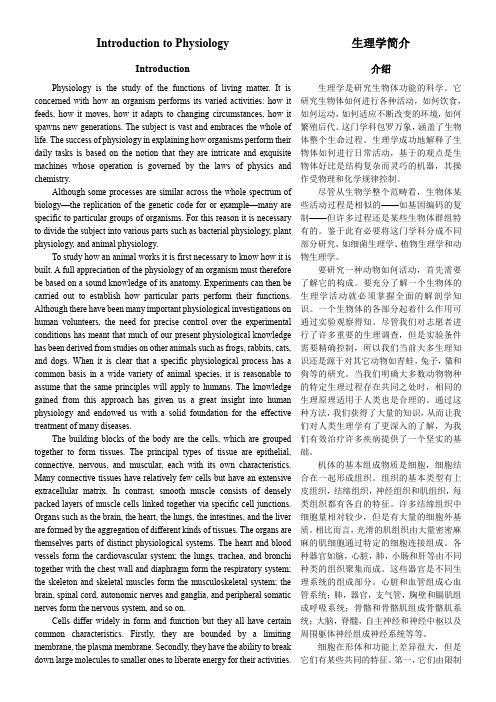
Introduction to PhysiologyIntroductionPhysiology is the study of the functions of living matter. It is concerned with how an organism performs its varied activities: how it feeds, how it moves, how it adapts to changing circumstances, how it spawns new generations. The subject is vast and embraces the whole of life. The success of physiology in explaining how organisms perform their daily tasks is based on the notion that they are intricate and exquisite machines whose operation is governed by the laws of physics and chemistry.Although some processes are similar across the whole spectrum of biology—the replication of the genetic code for or example—many are specific to particular groups of organisms. For this reason it is necessary to divide the subject into various parts such as bacterial physiology, plant physiology, and animal physiology.To study how an animal works it is first necessary to know how it is built. A full appreciation of the physiology of an organism must therefore be based on a sound knowledge of its anatomy. Experiments can then be carried out to establish how particular parts perform their functions. Although there have been many important physiological investigations on human volunteers, the need for precise control over the experimental conditions has meant that much of our present physiological knowledge has been derived from studies on other animals such as frogs, rabbits, cats, and dogs. When it is clear that a specific physiological process has a common basis in a wide variety of animal species, it is reasonable to assume that the same principles will apply to humans. The knowledge gained from this approach has given us a great insight into human physiology and endowed us with a solid foundation for the effective treatment of many diseases.The building blocks of the body are the cells, which are grouped together to form tissues. The principal types of tissue are epithelial, connective, nervous, and muscular, each with its own characteristics. Many connective tissues have relatively few cells but have an extensive extracellular matrix. In contrast, smooth muscle consists of densely packed layers of muscle cells linked together via specific cell junctions. Organs such as the brain, the heart, the lungs, the intestines, and the liver are formed by the aggregation of different kinds of tissues. The organs are themselves parts of distinct physiological systems. The heart and blood vessels form the cardiovascular system; the lungs, trachea, and bronchi together with the chest wall and diaphragm form the respiratory system; the skeleton and skeletal muscles form the musculoskeletal system; the brain, spinal cord, autonomic nerves and ganglia, and peripheral somatic nerves form the nervous system, and so on.Cells differ widely in form and function but they all have certain common characteristics. Firstly, they are bounded by a limiting membrane, the plasma membrane. Secondly, they have the ability to break down large molecules to smaller ones to liberate energy for their activities.生理学简介介绍生理学是研究生物体功能的科学。
药学英语第五版原文翻译

药学英语第五版原文翻译Introduction to PhysiologyIntroductionPhysiology is the study of the functions of living matter. It is concerned with how an organism performs its varied activities: how it feeds, how it moves, how it adapts to changing circumstances, how it spawns new generations. The subject is vast and embraces the whole of life. The success of physiology in explaining how organisms perform their daily tasks is based on the notion that they are intricate and exquisite machines whose operation is governed by the laws of physics and chemistry.Although some processes are similar across the whole spectrum of biology—the replication of the genetic code for or example—many are specific to particular groups of organisms. For this reason it is necessary to divide the subject into生理学简介介绍生理学是研究生物体功能的科学。
它研究生物体如何进行各种活动,如何饮食,如何运动,如何适应不断改变的环境,如何繁殖后代。
药学英语课文3翻译

Foods That Fight Cancer抗癌症的食物Foods That Fight CancerDiet is now considered a major weapon(武器) against cancer. The National Cancer Institute (协会)estimates that about one-third of all cancers are linked to diet, and recent research indicated(指出)that what you eat may help to significantly reduce your risk.Cancer develops over a long time, which means that you have years-typically decades(数十年)-in which to hinder(阻碍)or promote it. Researchers are finding that what you eat may interfere(妨碍)with cancer growth at various stages. For example, certain foods can block (v.阻碍) the chemicals that initiate(开始)cancer. Antioxidants(抗氧化剂), found in some vitamins and minerals(矿物), can snuff(消灭)out oxygen free radicals(基础;原子团), substances that are thought to make cells more susceptible(易受影响的)to cancer, and they can even repair some of the cellular damage that has been done. And some food-wheat bran in particular-has been shown to shrink(收缩)precancerous(癌症前期的)cells.A recent review(评论)of 17 studies from 17 nations reveals that people who eat the most fruits and vegetables have about half the cancer rates of those who eat the least. That includes cancers of the lung, colon(结肠), breast, cervix(宫颈), esophagus(食道), oral cavity(口腔), stomach, bladder(膀胱), pancreas(胰腺)and ovary(卵巢). In fact, some research suggests that frequent consumption(肺痨;消耗)of fruits and vegetables can cut the risk of lung cancer even in smokers. “It is almost mind-boggling(难以理解的),” says Tim Byers, an epidemiologist (流行病学家)with the U. S. Centers for Disease Control and Prevention, “that ordinary fruits and vegetables can be so effective against such a potent(有效的)carcinogen(致癌物质)as cigarette smoke.”One of the most studied antioxidants in vegetables and fruits thought to protect against cancer is beta-carotene(B-胡萝卜素), concentrated(聚集)in deep green, yellow and orange vegetables such as carrots, sweet potatoes and spinach(菠菜). Fruits high in beta-carotene include apricots (杏)and cantaloupes(哈密瓜). In test-tube(试管)studies at Harvard University, beta-carotene had a direct toxic effect on cells taken from malignant(有害的)tumors(肿瘤). It also reduced the growth of lung-cancer cells and altered(改变)the proteins needed for tumors to grow.Research also shows that beta-carotene can change in the body to retinoid acid(视黄酸), a substance used in clinical trials to treat certain cancers.Here are some of the foods that contain cancer-fighting chemicals.Tomatoes. One of the compounds in tomatoes that is thought to reduce the risk of cancer is lycopene(番茄红素), the pigment(色素)that makes tomatoes red. Lycopene, an antioxidant that is also found in watermelons and apricots, quenches(结束)certain cancer- triggering oxygen free radicals.Having little lycopene in your blood is associated with a higher risk of pancreatic cancer, according in a Johns Hopkins University study. People with pancreatic cancer showed lower levels of lycopene compared with healthy individuals. Those with the least blood lycopene had over five times the risk of pancreatic cancer as healthy people with the most blood lycopene.Lycopene is present in tomato products, including sauces(酱油), tomato paste and even ketchup(番茄酱).Green Vegetables. A recent Italian study showed that dark-green leafy vegetables lower the risk of many cancers. Spinach, broccoli(西兰花), kale(甘兰)and dark-green lettuces(油麦菜)are chock-full of antioxidants, including beta-carotene, folate and lutein,. A good rule ofthumb: the darker the vegetable, the more antioxidants within.Citrus(柑橘类)Fruit. “Eat oranges, grapefruits(葡萄柚), lemons and limes as often as possible,”says toxicologist Herbert Pierson, a former project officer with the National Cancer Institute. He calls citrus fruit an all-around cancer package because it possesses every class of natural substances (carotenoids(类胡萝卜素), flavonoids(黄铜)and others) that individually have neutralized(中立的)powerful chemical carcinogens in animals.Citrus fruit may be particularly effective in reducing the risk of pancreatic cancer. One study found that in a group of Swedes, those who ate a citrus fruit almost daily reduced the risk of pancreatic cancer by one-half to more than two-thirds, as compared with eating citrus fruit less than once a week.Cruciferous(十字花科的)Vegetables. Cruciferous vegetables, such as cabbage, cauliflower, Brussels sprouts, broccoli, kale, mustard greens and turnips, may reduce the risk of breast cancer. In fact, researchers at Eppley Institute for Research in Cancer and Allied diseases at the University of Nebraska at Omaha found that feeding animals cabbage and collard greens (also a cruciferous vegetable), along with a low-fat diet, reduced the incidence(发病率)of mammary(乳腺癌)cancers. Eat cruciferous vegetables raw(生食)or lightly cooked. Overcooking may destroy the indoles(吲哚), compounds found in these vegetables that may protect against cancer.Cruciferous vegetables may also work to head off stomach and colon cancer. Research conducted in Utah revealed(显示)that men who ate the most cruciferous vegetables had a 70 percent lower risk of colon cancer than those who ate the least of such vegetables.Soybeans. Soybeans contain at least five compounds believed to(抑制)cancer. In fact, one of the compounds is chemically similar to the drug tamoxifen (三苯氧胺), which is routinely used to treat estrogen-dependent(雌性激素)breast cancer and is now being tested in a large clinical trial to see if it can prevent the disease. In animal studies, soybean constituents have been found to block colon, skin and other cancers by possibly slowing the growth and division(分割)of cancer cells.Wheat Bran. Wheat bran may lower the risk of colon cancer. A double-blind(双盲)study of patients at The New York Hospital-Cornell Medical Center found that two one-ounce servings of wheat bran cereal(谷类)a day caused premalignant colon polyps(息肉)to shrink within six months. Most remarkable, say researchers, is that such a small amount of food could have such an impact within a short period of time, illustrating(图解)that dietary intervention(饮食干预)may work even after precancerous warning signs have appeared.Low-Fat Milk. While the saturated(饱和的)fat in milk seems to promote certain cancers, another substance in milk may deter(阻止)them. Researchers at Roswell Park Cancer Institute in Buffalo, N. Y., discovered, not surprisingly, that drinkers of whole milk had higher odds than non-milk-drinkers of developing cancers of the oral cavity, stomach, colon, rectum, lung, bladder, breast and cervix. But they also found that those drinking low-fat milk were less likely than non-milk-drinkers to develop cancers of the oral cavity, stomach, rectum and cervix. Why? Scientists suspect(猜想)that elements(基础)such as calcium, riboflavin, or vitamins A, C, and D (present in whole milk, too, but apparently less effective) may act as anti-cancer agents in ways not yet understood.To get the most cancer-protective compounds from your diet, strive(努力)for five or more servings of fruits and vegetables daily, advises the National Cancer Institute. One serving means one-half cup of most cooked or raw fruits or vegetables, one cup of raw leafy vegetables, onemedium(半生的)piece of fresh fruit, or six ounces of fruit juice or vegetable juice. The ideal diet is low in fat and calories, high in fiber, and it includes a variety of nutrient-rich foods such as fruits, vegetables, whole grains, beans, seeds, nuts(坚果)and, if desired, low-fat animal proteins.翻译:抗癌的食物现在饮食开始被考虑作为抵抗癌症的主要武器。
药学专业英语作文范文
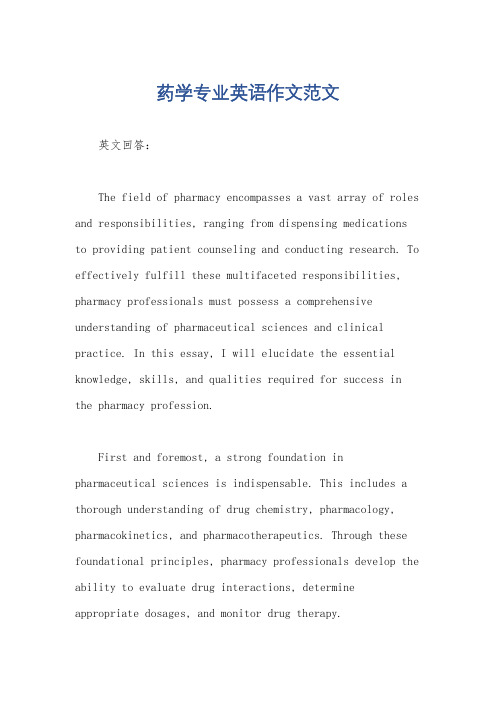
药学专业英语作文范文英文回答:The field of pharmacy encompasses a vast array of roles and responsibilities, ranging from dispensing medications to providing patient counseling and conducting research. To effectively fulfill these multifaceted responsibilities, pharmacy professionals must possess a comprehensive understanding of pharmaceutical sciences and clinical practice. In this essay, I will elucidate the essential knowledge, skills, and qualities required for success in the pharmacy profession.First and foremost, a strong foundation in pharmaceutical sciences is indispensable. This includes a thorough understanding of drug chemistry, pharmacology, pharmacokinetics, and pharmacotherapeutics. Through these foundational principles, pharmacy professionals develop the ability to evaluate drug interactions, determine appropriate dosages, and monitor drug therapy.Equally important are clinical practice skills. Pharmacy professionals are often the first point of contact for patients seeking healthcare advice. As such, they must possess strong communication and interpersonal skills to effectively interact with patients, understand their needs, and provide appropriate recommendations. In addition, pharmacy professionals must be proficient in medication counseling, patient education, and disease management.Beyond technical expertise, certain personal qualities are essential for success in the pharmacy profession. These include empathy, integrity, and a commitment to continuous learning. Pharmacy professionals must maintain accurate and confidential patient records. They must also stay abreast of the latest advancements in pharmaceutical sciences and clinical practice to ensure optimal patient outcomes.The pharmacy profession is a dynamic and ever-evolving field. As new technologies and therapies emerge, pharmacy professionals must adapt their knowledge and skills accordingly. To facilitate this process, continuingeducation and professional development are essential.In conclusion, the pharmacy profession demands a comprehensive understanding of pharmaceutical sciences, clinical practice skills, and personal qualities. Through a commitment to excellence and continuous learning, pharmacy professionals can make significant contributions to patient care and public health.中文回答:药学专业必备知识、技能和素质。
药学英语第五版原文翻译

IntroductiontoPhysiologyIntroductionPhysiologyisthestudyofthefunctionsoflivingmatter.Itisconcernedwithhowanorganismperformsitsv ariedactivities:howitfeeds,howitmoves,howitadaptstochangingcircumstances,howitspawnsnewgenerati ons.Thesubjectisvastandembracesthewholeoflife.Thesuccessofphysiologyinexplaininghoworganismsp erformtheirdailytasksisbasedonthenotionthattheyareintricateandexquisitemachineswhoseoperationisgo vernedbythelawsofphysicsandchemistry.Althoughsomeprocessesaresimilaracrossthewholespectrumofbiology—thereplicationofthegenetic codefororexample—manyarespecifictoparticulargroupsoforganisms.Forthisreasonitisnecessarytodivid ethesubjectintovariouspartssuchasbacterialphysiology,plantphysiology,andanimalphysiology.Tostudyhowananimalworksitisfirstnecessarytoknowhowitisbuilt.Afullappreciationofthephysiolog yofanorganismmustthereforebebasedonasoundknowledgeofitsanatomy.Experimentscanthenbecarriedo uttoestablishhowparticularpartsperformtheirfunctions.Althoughtherehavebeenmanyimportantphysiolo gicalinvestigationsonhumanvolunteers,theneedforprecisecontrolovertheexperimentalconditionshasmea ntthatmuchofourpresentphysiologicalknowledgehasbeenderivedfromstudiesonotheranimalssuchasfrog s,rabbits,cats,anddogs.Whenitisclearthataspecificphysiologicalprocesshasacommonbasisinawidevariet yofanimalspecies,itisreasonabletoassumethatthesameprincipleswillapplytohumans.Theknowledgegain edfromthisapproachhasgivenusagreatinsightintohumanphysiologyandendoweduswithasolidfoundation fortheeffectivetreatmentofmanydiseases.Thebuildingblocksofthebodyarethecells,whicharegroupedtogethertoformtissues.Theprincipaltype softissueareepithelial,connective,nervous,andmuscular,eachwithitsowncharacteristics.Manyconnective tissueshaverelativelyfewcellsbuthaveanextensiveextracellularmatrix.Incontrast,smoothmuscleconsists anssuchasthebrain,theh eart,thelungs,theintestines,andtheliverareformedbytheaggregationofdifferentkindsoftissues.Theorgans arethemselvespartsofdistinctphysiologicalsystems.Theheartandbloodvesselsformthecardiovascularsyst em;thelungs,trachea,andbronchitogetherwiththechestwallanddiaphragmformtherespiratorysystem;thes keletonandskeletalmusclesformthemusculoskeletalsystem;thebrain,spinalcord,autonomicnervesandgan glia,andperipheralsomaticnervesformthenervoussystem,andsoon.Cellsdifferwidelyinformandfunctionbuttheyallhavecertaincommoncharacteristics.Firstly,theyareb oundedbyalimitingmembrane,theplasmamembrane.Secondly,theyhavetheabilitytobreakdownlargemol eculestosmalleronestoliberateenergyfortheiractivities.Thirdly,atsomepointintheirlifehistory,theyposses sanucleuswhichcontainsgeneticinformationintheformofdeoxyribonucleicacid(DNA).Livingcellscontinuallytransformmaterials.Theybreakdownglucoseandfatstoprovideenergyforother activitiessuchasmotilityandthesynthesisofproteinsforgrowthandrepair.Thesechemicalchangesarecollect ivelycalledmetabolism.Thebreakdownoflargemoleculestosmalleronesiscalledcatabolismandthesynthes isoflargemoleculesfromsmalleronesanabolism.Inthecourseofevolution,cellsbegantodifferentiatetoservedifferentfunctions.Somedevelopedtheabil itytocontract(musclecells),otherstoconductelectricalsignals(nervecells).Afurthergroupdevelopedtheabi litytosecretedifferentsubstancessuchashormonesorenzymes.Duringembryologicaldevelopment,thispro cessofdifferentiationisre-enactedasmanydifferenttypesofcellareformedfromthefertilizedegg.Mosttissuescontainamixtureofcelltypes.Forexample,bloodconsistsofredcells,whitecells,andplatele ts.Redcellstransportoxygenaroundthebody.Thewhitecellsplayanimportantroleindefenseagainstinfection 生理学简介介绍生理学是研究生物体功能的科学。
药学相关英语短文范文
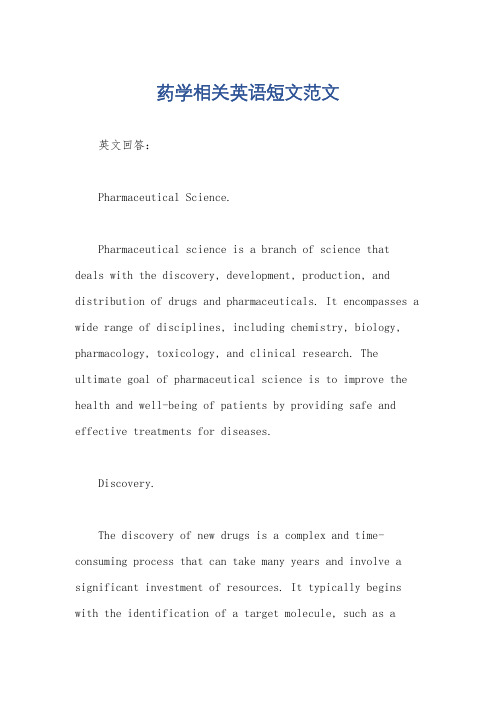
药学相关英语短文范文英文回答:Pharmaceutical Science.Pharmaceutical science is a branch of science that deals with the discovery, development, production, and distribution of drugs and pharmaceuticals. It encompasses a wide range of disciplines, including chemistry, biology, pharmacology, toxicology, and clinical research. The ultimate goal of pharmaceutical science is to improve the health and well-being of patients by providing safe and effective treatments for diseases.Discovery.The discovery of new drugs is a complex and time-consuming process that can take many years and involve a significant investment of resources. It typically begins with the identification of a target molecule, such as aprotein or enzyme, that is involved in the disease process. Once a target has been identified, researchers screen thousands of compounds to find those that bind to thetarget and produce the desired effect.Development.Once a promising compound has been identified, it must be further developed to ensure that it is safe andeffective for use in humans. This involves conducting a series of preclinical studies in animals to evaluate the drug's toxicity, efficacy, and pharmacokinetics. Once the drug has been shown to be safe and effective in animals, it can be advanced to clinical trials in humans.Production.The production of drugs and pharmaceuticals is a complex and highly regulated process. It involves a series of steps, including synthesis, purification, and packaging. The drug substance must be manufactured in accordance with strict quality standards to ensure that it is safe andeffective.Distribution.Once a drug has been approved for use, it must be distributed to patients. This involves a complex network of wholesalers, distributors, and pharmacies. The drug must be stored and transported under appropriate conditions to ensure that it remains safe and effective.中文回答:药学。
(完整版)药学英语第五版原文翻译

Introduction to PhysiologyIntroductionPhysiology is the study of the functions of living matter. It is concerned with how an organism performs its varied activities: how it feeds, how it moves, how it adapts to changing circumstances, how it spawns new generations. The subject is vast and embraces the whole of life. The success of physiology in explaining how organisms perform their daily tasks is based on the notion that they are intricate and exquisite machines whose operation is governed by the laws of physics and chemistry.Although some processes are similar across the whole spectrum of biology—the replication of the genetic code for or example—many are specific to particular groups of organisms. For this reason it is necessary to divide the subject into various parts such as bacterial physiology, plant physiology, and animal physiology.To study how an animal works it is first necessary to know how it is built. A full appreciation of the physiology of an organism must therefore be based on a sound knowledge of its anatomy. Experiments can then be carried out to establish how particular parts perform their functions. Although there have been many important physiological investigations on human volunteers, the need for precise control over the experimental conditions has meant that much of our present physiological knowledge has been derived from studies on other animals such as frogs, rabbits, cats, and dogs. When it is clear that a specific physiological process has a common basis in a wide variety of animal species, it is reasonable to assume that the same principles will apply to humans. The knowledge gained from this approach has given us a great insight into human physiology and endowed us with a solid foundation for the effective treatment of many diseases.The building blocks of the body are the cells, which are grouped together to form tissues. The principal types of tissue are epithelial, connective, nervous, and muscular, each with its own characteristics. Many connective tissues have relatively few cells but have an extensive extracellular matrix. In contrast, smooth muscle consists of densely packed layers of muscle cells linked together via specific cell junctions. Organs such as the brain, the heart, the lungs, the intestines, and the liver are formed by the aggregation of different kinds of tissues. The organs are themselves parts of distinct physiological systems. The heart and blood vessels form the cardiovascular system; the lungs, trachea, and bronchi together with the chest wall and diaphragm form the respiratory system; the skeleton and skeletal muscles form the musculoskeletal system; the brain, spinal cord, autonomic nerves and ganglia, and peripheral somatic nerves form the nervous system, and so on.Cells differ widely in form and function but they all have certain common characteristics. Firstly, they are bounded by a limiting membrane, the plasma membrane. Secondly, they have the ability to break down large molecules to smaller ones to liberate energy for their activities.生理学简介介绍生理学是研究生物体功能的科学。
药品专业英文介绍作文
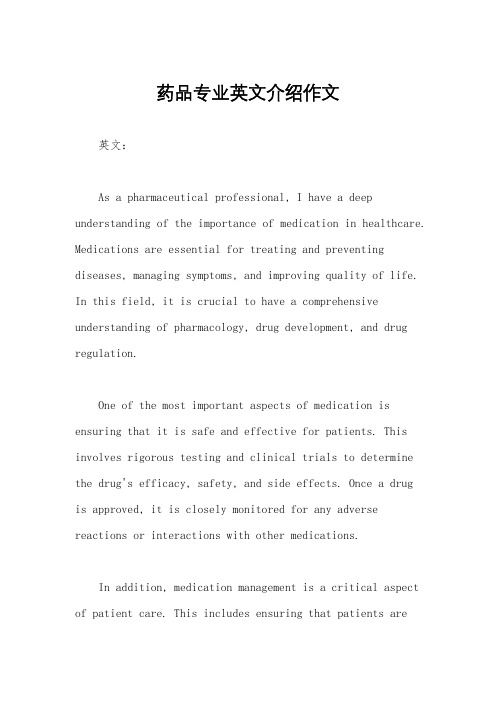
药品专业英文介绍作文英文:As a pharmaceutical professional, I have a deep understanding of the importance of medication in healthcare. Medications are essential for treating and preventing diseases, managing symptoms, and improving quality of life. In this field, it is crucial to have a comprehensive understanding of pharmacology, drug development, and drug regulation.One of the most important aspects of medication is ensuring that it is safe and effective for patients. This involves rigorous testing and clinical trials to determine the drug's efficacy, safety, and side effects. Once a drugis approved, it is closely monitored for any adverse reactions or interactions with other medications.In addition, medication management is a critical aspect of patient care. This includes ensuring that patients aretaking their medications as prescribed, monitoring for any adverse reactions or interactions, and providing education on how to properly use and store medications.As a pharmaceutical professional, I am committed to ensuring that patients receive the best possible care and treatment through the safe and effective use of medications.中文:作为一名药品专业人士,我深知药物在医疗保健中的重要性。
药学作文模板英语初三
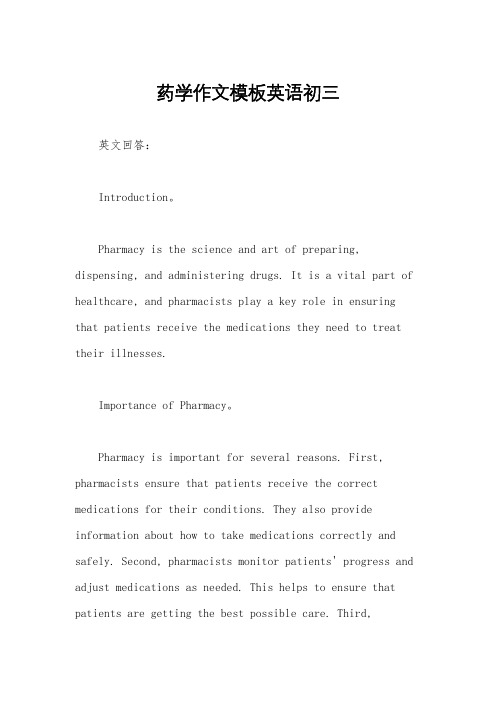
药学作文模板英语初三英文回答:Introduction。
Pharmacy is the science and art of preparing, dispensing, and administering drugs. It is a vital part of healthcare, and pharmacists play a key role in ensuring that patients receive the medications they need to treat their illnesses.Importance of Pharmacy。
Pharmacy is important for several reasons. First, pharmacists ensure that patients receive the correct medications for their conditions. They also provide information about how to take medications correctly and safely. Second, pharmacists monitor patients' progress and adjust medications as needed. This helps to ensure that patients are getting the best possible care. Third,pharmacists can help to prevent drug interactions and other adverse events. They can also provide information about the cost of medications and help patients find ways to save money.Education and Training。
药学专升本英语作文范文
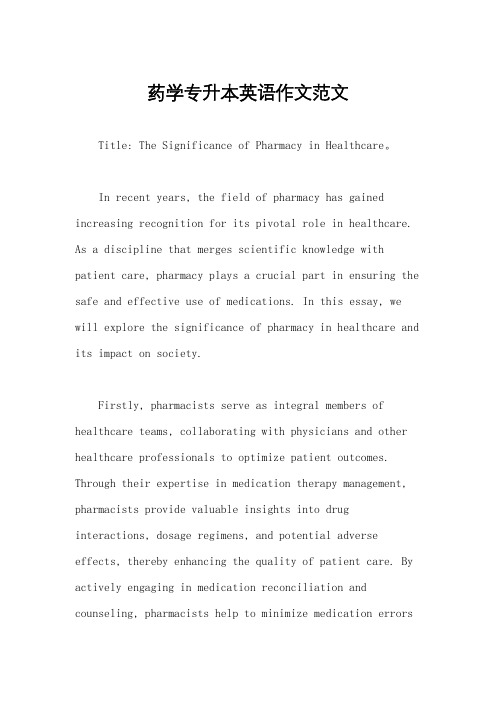
药学专升本英语作文范文Title: The Significance of Pharmacy in Healthcare。
In recent years, the field of pharmacy has gained increasing recognition for its pivotal role in healthcare. As a discipline that merges scientific knowledge with patient care, pharmacy plays a crucial part in ensuring the safe and effective use of medications. In this essay, we will explore the significance of pharmacy in healthcare and its impact on society.Firstly, pharmacists serve as integral members of healthcare teams, collaborating with physicians and other healthcare professionals to optimize patient outcomes. Through their expertise in medication therapy management, pharmacists provide valuable insights into drug interactions, dosage regimens, and potential adverse effects, thereby enhancing the quality of patient care. By actively engaging in medication reconciliation and counseling, pharmacists help to minimize medication errorsand improve medication adherence, ultimately leading to better patient outcomes and reduced healthcare costs.Moreover, pharmacy encompasses various specialized areas that cater to the diverse needs of patients. Clinical pharmacists, for instance, work closely with physicians to develop personalized treatment plans for patients with complex medical conditions. They conduct comprehensive medication reviews, monitor therapeutic responses, and make evidence-based recommendations to optimize drug therapy. Similarly, community pharmacists play a vital role in promoting public health by providing essential services such as immunizations, health screenings, and medication therapy management consultations. By leveraging their accessibility and expertise, community pharmacists serve as trusted healthcare advisors within their communities, empowering individuals to make informed decisions about their health.Furthermore, the field of pharmacy continues to evolve in response to advancements in healthcare technology and scientific research. Pharmacogenomics, for example,explores the relationship between an individual's genetic makeup and their response to medications, paving the wayfor personalized medicine approaches. Pharmacists, equipped with knowledge in pharmacogenomics, can tailor drug therapy to individual patients based on their genetic profiles, maximizing efficacy and minimizing adverse reactions. Similarly, the emergence of telepharmacy and digital health platforms has transformed the delivery of pharmaceutical care, enabling remote medication counseling, adherence monitoring, and medication management services. These technological innovations not only enhance accessibility to pharmacy services but also facilitate proactive healthcare management, particularly in underserved communities.In addition to their clinical roles, pharmacists contribute to healthcare policy development, medication safety initiatives, and public health advocacy efforts. As medication experts, pharmacists possess valuable insights into the regulatory landscape governing pharmaceuticals and healthcare delivery systems. They actively participate in medication safety committees, drug formulary reviews, and medication error reporting systems to promote safermedication practices and prevent adverse events. Furthermore, pharmacists advocate for policies that expand access to affordable medications, improve medication labeling and packaging standards, and address medication shortages. By engaging in these advocacy efforts, pharmacists champion the interests of patients and uphold the principles of patient-centered care.In conclusion, pharmacy plays a multifaceted role in healthcare, encompassing clinical practice, public health, research, and advocacy. Pharmacists serve as essential healthcare providers, collaborating with interdisciplinary teams to optimize medication therapy and improve patient outcomes. Through their expertise, innovation, and commitment to patient care, pharmacists continue to make invaluable contributions to the advancement of healthcare worldwide. As the healthcare landscape evolves, the role of pharmacy will only grow in importance, reaffirming its status as a cornerstone of modern healthcare delivery.。
药学英语第五版原文翻译.doc
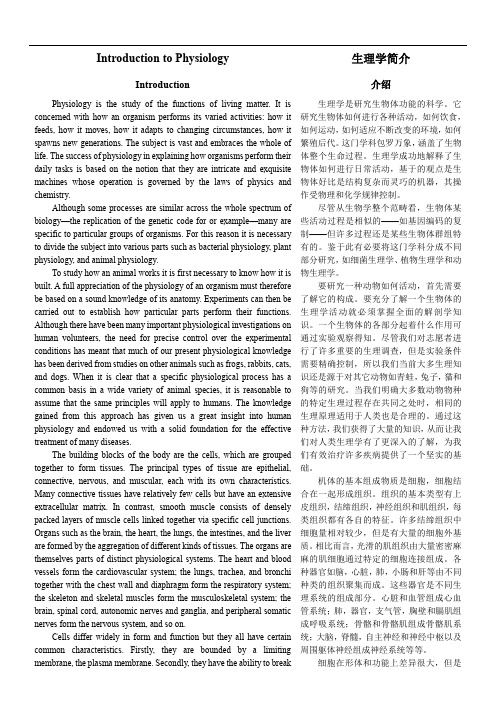
Introduction to PhysiologyIntroductionPhysiology is the study of the functions of living matter. It is concerned with how an organism performs its varied activities: how it feeds, how it moves, how it adapts to changing circumstances, how it spawns new generations. The subject is vast and embraces the whole of life. The success of physiology in explaining how organisms perform their daily tasks is based on the notion that they are intricate and exquisite machines whose operation is governed by the laws of physics and chemistry.Although some processes are similar across the whole spectrum of biology—the replication of the genetic code for or example—many are specific to particular groups of organisms. For this reason it is necessary to divide the subject into various parts such as bacterial physiology, plant physiology, and animal physiology.To study how an animal works it is first necessary to know how it is built. A full appreciation of the physiology of an organism must therefore be based on a sound knowledge of its anatomy. Experiments can then be carried out to establish how particular parts perform their functions. Although there have been many important physiological investigations on human volunteers, the need for precise control over the experimental conditions has meant that much of our present physiological knowledge has been derived from studies on other animals such as frogs, rabbits, cats, and dogs. When it is clear that a specific physiological process has a common basis in a wide variety of animal species, it is reasonable to assume that the same principles will apply to humans. The knowledge gained from this approach has given us a great insight into human physiology and endowed us with a solid foundation for the effective treatment of many diseases.The building blocks of the body are the cells, which are grouped together to form tissues. The principal types of tissue are epithelial, connective, nervous, and muscular, each with its own characteristics. Many connective tissues have relatively few cells but have an extensive extracellular matrix. In contrast, smooth muscle consists of densely packed layers of muscle cells linked together via specific cell junctions. Organs such as the brain, the heart, the lungs, the intestines, and the liver are formed by the aggregation of different kinds of tissues. The organs are themselves parts of distinct physiological systems. The heart and blood vessels form the cardiovascular system; the lungs, trachea, and bronchi together with the chest wall and diaphragm form the respiratory system; the skeleton and skeletal muscles form the musculoskeletal system; the brain, spinal cord, autonomic nerves and ganglia, and peripheral somatic nerves form the nervous system, and so on.Cells differ widely in form and function but they all have certain common characteristics. Firstly, they are bounded by a limiting membrane, the plasma membrane. Secondly, they have the ability to break生理学简介介绍生理学是研究生物体功能的科学。
药学英语第五版原文翻译.doc
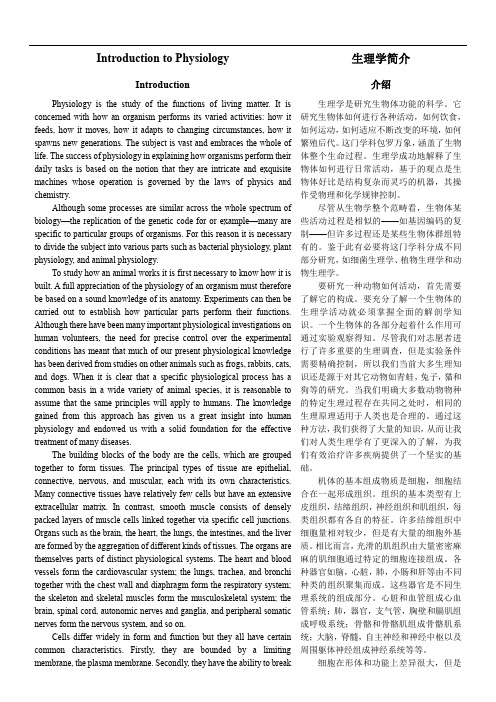
Introduction to PhysiologyIntroductionPhysiology is the study of the functions of living matter. It is concerned with how an organism performs its varied activities: how it feeds, how it moves, how it adapts to changing circumstances, how it spawns new generations. The subject is vast and embraces the whole of life. The success of physiology in explaining how organisms perform their daily tasks is based on the notion that they are intricate and exquisite machines whose operation is governed by the laws of physics and chemistry.Although some processes are similar across the whole spectrum of biology—the replication of the genetic code for or example—many are specific to particular groups of organisms. For this reason it is necessary to divide the subject into various parts such as bacterial physiology, plant physiology, and animal physiology.To study how an animal works it is first necessary to know how it is built. A full appreciation of the physiology of an organism must therefore be based on a sound knowledge of its anatomy. Experiments can then be carried out to establish how particular parts perform their functions. Although there have been many important physiological investigations on human volunteers, the need for precise control over the experimental conditions has meant that much of our present physiological knowledge has been derived from studies on other animals such as frogs, rabbits, cats, and dogs. When it is clear that a specific physiological process has a common basis in a wide variety of animal species, it is reasonable to assume that the same principles will apply to humans. The knowledge gained from this approach has given us a great insight into human physiology and endowed us with a solid foundation for the effective treatment of many diseases.The building blocks of the body are the cells, which are grouped together to form tissues. The principal types of tissue are epithelial, connective, nervous, and muscular, each with its own characteristics. Many connective tissues have relatively few cells but have an extensive extracellular matrix. In contrast, smooth muscle consists of densely packed layers of muscle cells linked together via specific cell junctions. Organs such as the brain, the heart, the lungs, the intestines, and the liver are formed by the aggregation of different kinds of tissues. The organs are themselves parts of distinct physiological systems. The heart and blood vessels form the cardiovascular system; the lungs, trachea, and bronchi together with the chest wall and diaphragm form the respiratory system; the skeleton and skeletal muscles form the musculoskeletal system; the brain, spinal cord, autonomic nerves and ganglia, and peripheral somatic nerves form the nervous system, and so on.Cells differ widely in form and function but they all have certain common characteristics. Firstly, they are bounded by a limiting membrane, the plasma membrane. Secondly, they have the ability to break生理学简介介绍生理学是研究生物体功能的科学。
药学英语第五版原文翻译.doc
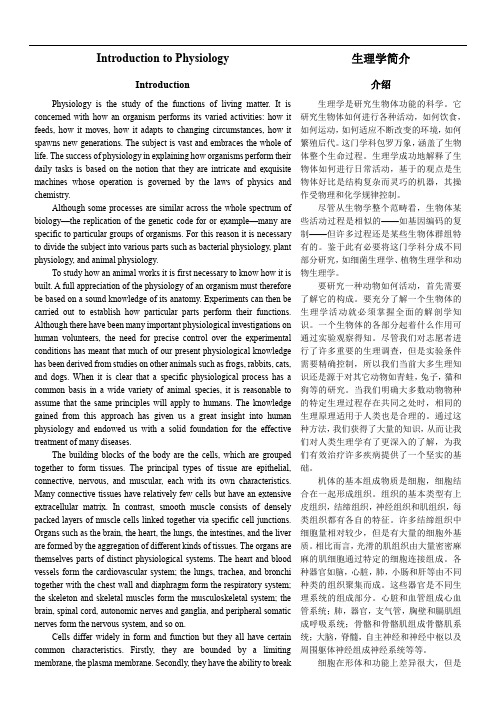
Introduction to PhysiologyIntroductionPhysiology is the study of the functions of living matter. It is concerned with how an organism performs its varied activities: how it feeds, how it moves, how it adapts to changing circumstances, how it spawns new generations. The subject is vast and embraces the whole of life. The success of physiology in explaining how organisms perform their daily tasks is based on the notion that they are intricate and exquisite machines whose operation is governed by the laws of physics and chemistry.Although some processes are similar across the whole spectrum of biology—the replication of the genetic code for or example—many are specific to particular groups of organisms. For this reason it is necessary to divide the subject into various parts such as bacterial physiology, plant physiology, and animal physiology.To study how an animal works it is first necessary to know how it is built. A full appreciation of the physiology of an organism must therefore be based on a sound knowledge of its anatomy. Experiments can then be carried out to establish how particular parts perform their functions. Although there have been many important physiological investigations on human volunteers, the need for precise control over the experimental conditions has meant that much of our present physiological knowledge has been derived from studies on other animals such as frogs, rabbits, cats, and dogs. When it is clear that a specific physiological process has a common basis in a wide variety of animal species, it is reasonable to assume that the same principles will apply to humans. The knowledge gained from this approach has given us a great insight into human physiology and endowed us with a solid foundation for the effective treatment of many diseases.The building blocks of the body are the cells, which are grouped together to form tissues. The principal types of tissue are epithelial, connective, nervous, and muscular, each with its own characteristics. Many connective tissues have relatively few cells but have an extensive extracellular matrix. In contrast, smooth muscle consists of densely packed layers of muscle cells linked together via specific cell junctions. Organs such as the brain, the heart, the lungs, the intestines, and the liver are formed by the aggregation of different kinds of tissues. The organs are themselves parts of distinct physiological systems. The heart and blood vessels form the cardiovascular system; the lungs, trachea, and bronchi together with the chest wall and diaphragm form the respiratory system; the skeleton and skeletal muscles form the musculoskeletal system; the brain, spinal cord, autonomic nerves and ganglia, and peripheral somatic nerves form the nervous system, and so on.Cells differ widely in form and function but they all have certain common characteristics. Firstly, they are bounded by a limiting membrane, the plasma membrane. Secondly, they have the ability to break生理学简介介绍生理学是研究生物体功能的科学。
药学英语第五版原文翻译.doc
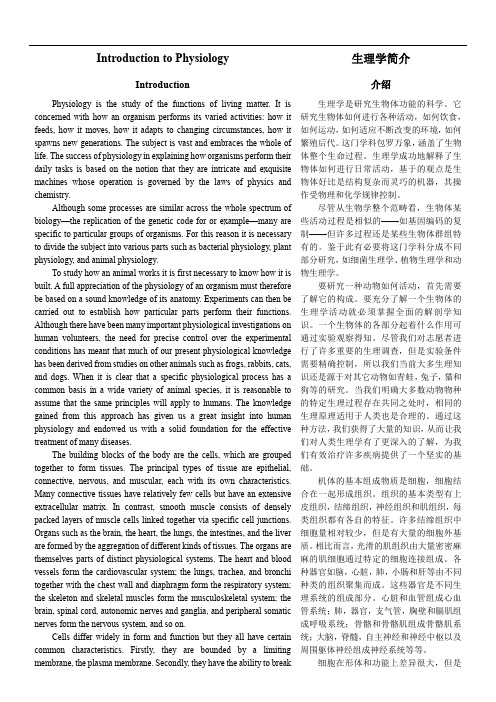
Introduction to PhysiologyIntroductionPhysiology is the study of the functions of living matter. It is concerned with how an organism performs its varied activities: how it feeds, how it moves, how it adapts to changing circumstances, how it spawns new generations. The subject is vast and embraces the whole of life. The success of physiology in explaining how organisms perform their daily tasks is based on the notion that they are intricate and exquisite machines whose operation is governed by the laws of physics and chemistry.Although some processes are similar across the whole spectrum of biology—the replication of the genetic code for or example—many are specific to particular groups of organisms. For this reason it is necessary to divide the subject into various parts such as bacterial physiology, plant physiology, and animal physiology.To study how an animal works it is first necessary to know how it is built. A full appreciation of the physiology of an organism must therefore be based on a sound knowledge of its anatomy. Experiments can then be carried out to establish how particular parts perform their functions. Although there have been many important physiological investigations on human volunteers, the need for precise control over the experimental conditions has meant that much of our present physiological knowledge has been derived from studies on other animals such as frogs, rabbits, cats, and dogs. When it is clear that a specific physiological process has a common basis in a wide variety of animal species, it is reasonable to assume that the same principles will apply to humans. The knowledge gained from this approach has given us a great insight into human physiology and endowed us with a solid foundation for the effective treatment of many diseases.The building blocks of the body are the cells, which are grouped together to form tissues. The principal types of tissue are epithelial, connective, nervous, and muscular, each with its own characteristics. Many connective tissues have relatively few cells but have an extensive extracellular matrix. In contrast, smooth muscle consists of densely packed layers of muscle cells linked together via specific cell junctions. Organs such as the brain, the heart, the lungs, the intestines, and the liver are formed by the aggregation of different kinds of tissues. The organs are themselves parts of distinct physiological systems. The heart and blood vessels form the cardiovascular system; the lungs, trachea, and bronchi together with the chest wall and diaphragm form the respiratory system; the skeleton and skeletal muscles form the musculoskeletal system; the brain, spinal cord, autonomic nerves and ganglia, and peripheral somatic nerves form the nervous system, and so on.Cells differ widely in form and function but they all have certain common characteristics. Firstly, they are bounded by a limiting membrane, the plasma membrane. Secondly, they have the ability to break生理学简介介绍生理学是研究生物体功能的科学。
药学英语第五版原文翻译.doc
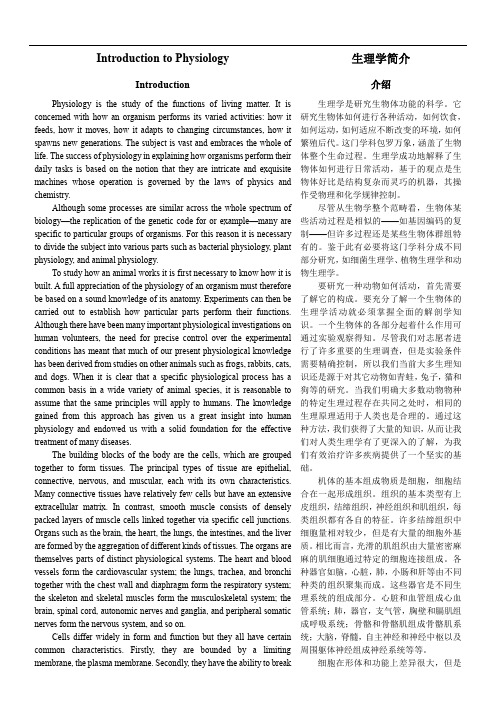
Introduction to PhysiologyIntroductionPhysiology is the study of the functions of living matter. It is concerned with how an organism performs its varied activities: how it feeds, how it moves, how it adapts to changing circumstances, how it spawns new generations. The subject is vast and embraces the whole of life. The success of physiology in explaining how organisms perform their daily tasks is based on the notion that they are intricate and exquisite machines whose operation is governed by the laws of physics and chemistry.Although some processes are similar across the whole spectrum of biology—the replication of the genetic code for or example—many are specific to particular groups of organisms. For this reason it is necessary to divide the subject into various parts such as bacterial physiology, plant physiology, and animal physiology.To study how an animal works it is first necessary to know how it is built. A full appreciation of the physiology of an organism must therefore be based on a sound knowledge of its anatomy. Experiments can then be carried out to establish how particular parts perform their functions. Although there have been many important physiological investigations on human volunteers, the need for precise control over the experimental conditions has meant that much of our present physiological knowledge has been derived from studies on other animals such as frogs, rabbits, cats, and dogs. When it is clear that a specific physiological process has a common basis in a wide variety of animal species, it is reasonable to assume that the same principles will apply to humans. The knowledge gained from this approach has given us a great insight into human physiology and endowed us with a solid foundation for the effective treatment of many diseases.The building blocks of the body are the cells, which are grouped together to form tissues. The principal types of tissue are epithelial, connective, nervous, and muscular, each with its own characteristics. Many connective tissues have relatively few cells but have an extensive extracellular matrix. In contrast, smooth muscle consists of densely packed layers of muscle cells linked together via specific cell junctions. Organs such as the brain, the heart, the lungs, the intestines, and the liver are formed by the aggregation of different kinds of tissues. The organs are themselves parts of distinct physiological systems. The heart and blood vessels form the cardiovascular system; the lungs, trachea, and bronchi together with the chest wall and diaphragm form the respiratory system; the skeleton and skeletal muscles form the musculoskeletal system; the brain, spinal cord, autonomic nerves and ganglia, and peripheral somatic nerves form the nervous system, and so on.Cells differ widely in form and function but they all have certain common characteristics. Firstly, they are bounded by a limiting membrane, the plasma membrane. Secondly, they have the ability to break生理学简介介绍生理学是研究生物体功能的科学。
药学英语第五版原文翻译.doc
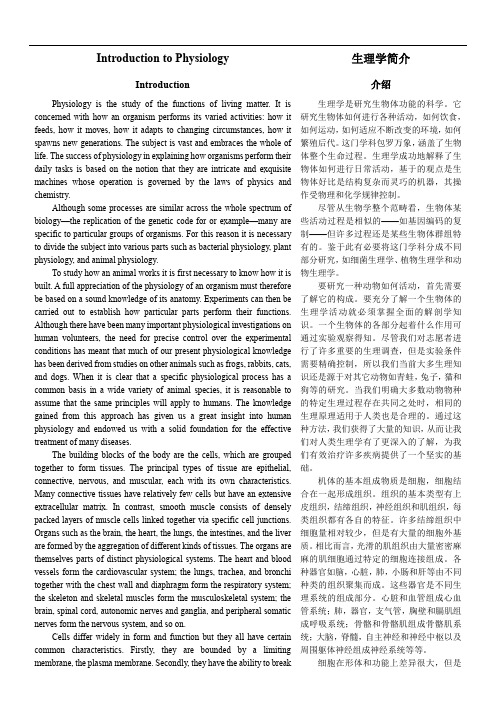
Introduction to PhysiologyIntroductionPhysiology is the study of the functions of living matter. It is concerned with how an organism performs its varied activities: how it feeds, how it moves, how it adapts to changing circumstances, how it spawns new generations. The subject is vast and embraces the whole of life. The success of physiology in explaining how organisms perform their daily tasks is based on the notion that they are intricate and exquisite machines whose operation is governed by the laws of physics and chemistry.Although some processes are similar across the whole spectrum of biology—the replication of the genetic code for or example—many are specific to particular groups of organisms. For this reason it is necessary to divide the subject into various parts such as bacterial physiology, plant physiology, and animal physiology.To study how an animal works it is first necessary to know how it is built. A full appreciation of the physiology of an organism must therefore be based on a sound knowledge of its anatomy. Experiments can then be carried out to establish how particular parts perform their functions. Although there have been many important physiological investigations on human volunteers, the need for precise control over the experimental conditions has meant that much of our present physiological knowledge has been derived from studies on other animals such as frogs, rabbits, cats, and dogs. When it is clear that a specific physiological process has a common basis in a wide variety of animal species, it is reasonable to assume that the same principles will apply to humans. The knowledge gained from this approach has given us a great insight into human physiology and endowed us with a solid foundation for the effective treatment of many diseases.The building blocks of the body are the cells, which are grouped together to form tissues. The principal types of tissue are epithelial, connective, nervous, and muscular, each with its own characteristics. Many connective tissues have relatively few cells but have an extensive extracellular matrix. In contrast, smooth muscle consists of densely packed layers of muscle cells linked together via specific cell junctions. Organs such as the brain, the heart, the lungs, the intestines, and the liver are formed by the aggregation of different kinds of tissues. The organs are themselves parts of distinct physiological systems. The heart and blood vessels form the cardiovascular system; the lungs, trachea, and bronchi together with the chest wall and diaphragm form the respiratory system; the skeleton and skeletal muscles form the musculoskeletal system; the brain, spinal cord, autonomic nerves and ganglia, and peripheral somatic nerves form the nervous system, and so on.Cells differ widely in form and function but they all have certain common characteristics. Firstly, they are bounded by a limiting membrane, the plasma membrane. Secondly, they have the ability to break生理学简介介绍生理学是研究生物体功能的科学。
药学作文模板英语翻译版
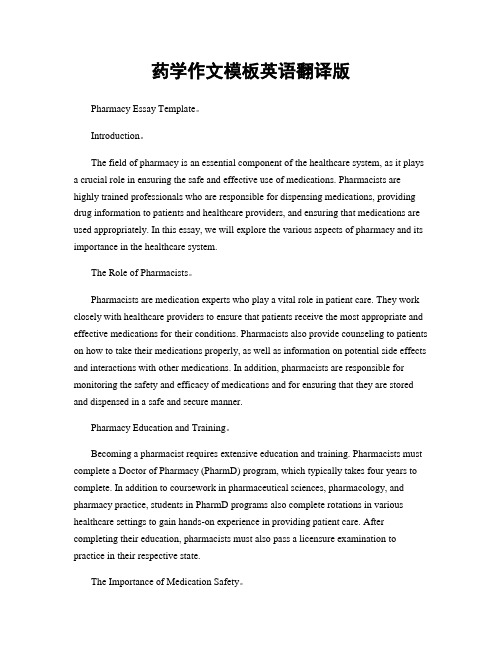
药学作文模板英语翻译版Pharmacy Essay Template。
Introduction。
The field of pharmacy is an essential component of the healthcare system, as it plays a crucial role in ensuring the safe and effective use of medications. Pharmacists are highly trained professionals who are responsible for dispensing medications, providing drug information to patients and healthcare providers, and ensuring that medications are used appropriately. In this essay, we will explore the various aspects of pharmacy and its importance in the healthcare system.The Role of Pharmacists。
Pharmacists are medication experts who play a vital role in patient care. They work closely with healthcare providers to ensure that patients receive the most appropriate and effective medications for their conditions. Pharmacists also provide counseling to patients on how to take their medications properly, as well as information on potential side effects and interactions with other medications. In addition, pharmacists are responsible for monitoring the safety and efficacy of medications and for ensuring that they are stored and dispensed in a safe and secure manner.Pharmacy Education and Training。
- 1、下载文档前请自行甄别文档内容的完整性,平台不提供额外的编辑、内容补充、找答案等附加服务。
- 2、"仅部分预览"的文档,不可在线预览部分如存在完整性等问题,可反馈申请退款(可完整预览的文档不适用该条件!)。
- 3、如文档侵犯您的权益,请联系客服反馈,我们会尽快为您处理(人工客服工作时间:9:00-18:30)。
Expression of livin in gastric cancer and induction of apoptosis in SGC-7901 cells by shRNA-mediated silencing of livin geneBackground-Because of increased resistance to apoptosis in tumor cells, inhibition of specific antiapoptotic factors may provide a rational approach for the development of novel therapeutic strategies.Livin, a novel inhibitor of apoptosis protein family, has been found to be expressed in various malignancies and is suggested to have poorly prognostic significance. However, no data are available concerning the significance of livin in gastric cancer. In this study, we detected the expression of livin in human gastric carcinoma and investigated the apoptotic susceptibility of SGC-7901 cell by shRNAmediated silencing of the livin gene.Methods-The mRNA and protein expression of livin were analyzed by RT-PCR and western blot assay.The relationship between livin expression and clinical pathologic parameters was investigated. The small interfering RNA eukaryotic expression vector specific to livin was constructed by gene recombination, and the nucleic acid was sequenced. Then it was transfected into SGC-7901 cells by Lipofectamin 2000. RT-PCR and Western blot assay were used to validate gene-silencing efficiency of livin in SGC-7901 cells. Stable clones were obtained by G418 screening. The cell apoptosis was assessed by flow cytometry (FCM). Cell growth state and 50 % inhibition concentration (IC50) of 5-FU and cisplatin was determined by MTT method.Results-The expression of livin mRNA and protein were detected in 19 of 40 gastric carcinoma cases (47.5%) and SGC-7901 cells. No expression of livin was detected in tumor adjacent tissues and benign gastric lesion. The positive correlation was found between livin expression and poor differentiation of tumors as well as lymph node metastases (P < 0.05). Four small interfering RNA eukaryotic expression vector specific to livin were constructed by gene recombination. And one of them can efficiently decrease the expression of livin, the inhibition of the gene was not less than 70% (P < 0.01). The recombinated plasmids were extracted and transfected gastric cancer cells. The stable clones were obtained by G418 screening, and were amplified and cultured. When livin gene was silenced, the reproductive activity of the gastric cancer cells was significantly lower than the control groups(P < 0.05). The study also showed that IC50 of 5-Fu and cisplatin on gastric cancer cells treated by shRNA wasdecreased and the cells were more susceptible to proapoptotic stimuli (5-Fu and cisplatin) (P < 0.01).Conclusions-C Livin is overexpressed in gastric carcinoma with a relationship to tumor differentiation and lymph node metastases, which is suggested to be one of the molecular prognostic factors for some cases of gastric cancer. ShRNA can inhibit livin expression in SGC-7901 cells and induce cell apoptosis.Livin may serve as a new target for apoptosis-inducing therapy of gastric cancer.1. IntroductionGastric cancer is one of the most common malignancies in the world. Most patients with this disease are diagnosed in advanced stages, and lose the chance of surgical eradication. Despite much progress in chemotherapy, the overall survival of the patients with gastric cancer in advanced stage is still poor. Resistance of cancer cells to chemoagents may contribute to failure of the treatment. Among the reasons of drug resistance, inhibited process of cell apoptosis may play an important role.Cancer cells are often characterized by increased resistance to apoptosis [1], which mediates their increased resistance to various stimuli of cell apoptosis, such as DNA damage, hypoxia, nutrient-deprivation [2,3]. Moreover, apoptosis resistance is considered to be a major cause of therapeutic failure for tumors in clinical practice, since many chemo- and/or radiotherapeutic agents function through the induction of apoptotic tumor death [4].Inhibitor of apoptosis protein (IAPs) is a novel family of intracellular proteins which suppress apoptosis induced by a variety of stimuli [5,6], including viral infection, chemotherapeutic drugs, staurosporin, growth factor withdrawal, and by components of the tumor necrosis factor-a (TNF-a)/Fas apoptotic signaling pathways [7¨C9]. The IAPs consists of a group of structurally related proteins with antiapoptotic properties [10], and may play a substantial role in preventing tumor cell from apoptosis, and has become the focus of research in recent years. A novel member of this family is ML-IAP/livin/KIAP/BIRC7 (in the following termed livin) which has two isoforms, livin a and livin b [11¨C14]. It has been shown that over-expression of the livin can block apoptosis induced by a variety of proapoptotic stimuli [12]. Interestingly, livin gene has been found to be restrictively expressed in tumor cells, but not, or to lesser amounts in most normal adult tissues [11¨C15], and may contribute to tumorigenesis by allowing malignant cell to avoid apoptotic cell death. So inhibition of livin expression may represent an interesting therapeutic strategy.In the present study, we investigated the expression of livin in gastric cancinomas and their adjacent tissues. The relationship between livin expression and clinical pathologic parameters was analyzed. Furthermore, we explored the feasibility of shRNA in inhibiting livin gene expression and the apoptotic susceptibility of gastric cancer cell by shRNA-mediated silencing of the livin gene.2. Patients and methods2.1. Patients and tumor samplesForty samples of gastric carcinoma and 13 samples of paracancerous tissues were collected from the patients who received gastrectomy (age of patients ranging from 29-77 years). Thirteen samples of benign gastric lesion (chronic superficial gastritis) were gained from the patients undergoing gastric endoscopic examination (age of patients ranging from 33-77 years). These samples were collected from patients admitted to the First Affiliated Hospital of Nanjing Medical University. The patients with gastric cancer were diagnosed as being in stage I to IV based on TNM classification (UICC, 2002). Tumor specimens were immediately frozen in liquid nitrogen after surgery and stored at -80℃until use. Informed consent was obtained from all patients.2.2. RT-PCR procedureTotal RNA (2 mg) extracted from frozen tissues was reverse transcribed in a final volume of 25 ml with 100 pmol of oligo(dT)15 and 200U M-MLV reverse transcriptase (promega, USA), according to the manufacturer’s guidelines.Aliquots corresponding to 2.5 ml cDNA were then amplified in PCR buffer containing 25pmol/ml each primer and 1 U Taq polymerase in a final volume of 50 ml. Each amplification was performed for 35 cycles, one cycle profile consisted of denaturationat 94 8C for 30 s, annealing at 59 8C (livin and b-actin) for 30 s and extension at 72 8C for 30 s. A sample without RNA was included in each RT¨CPCR as a negative control.Sequences of livin and β-actin primers used are as follows:livina/b up stream,50-TCCACAGTGTGCAGGAGACT-30;livina/βdownstream,50-ACGGCACA AAGACGATGGAC-30;b-actinupstream,50-AGCGCAAGTACTCCGTGTG-30;β-acti n downstream, 50-AAGCAATGCTATCACCTCCC-30.The size of the amplified products were312/258 bp for livina/b and 501 bp for b-actin respectively.2.3. Western Blot AnalysisTissues were homogenized with lysis buffer [50 mM Tris-HCl(pH 7.5), 250 mMNaCl, 0.1% NP40, and 5 mM EGTA containing 50 mM sodium fluoride, 60 mM b-glycerol-phosphate, 0.5 mM sodium vanadate, 0.1 mM phenylmethylsulfonyl fluoride, 10 mg/ml aprotinin, and 10 mg/ml leupeptin. The total protein concentration was determined using Coomassie Brilliant Blue. Protein samples were electrophoresed in a 10% denaturing SDS gel and transferred to PVDF membrane (Roche, USA). The membranes were incubated with specific primary antibodies, reacted with a peroxidase-conjugated secondary antibody (Cell signaling technology,USA), and finally visualized by enhanced chemiluminescence (Cell signaling technology, USA). Monoclonal antibodies recognizing livin (1:250) and actin (1:400) were purchased from Alexesis Inc. (USA) and Santa Cruz Biotechnology (USA).2.4. Cell lines and cell cultureWe selected a human gastric adenocarcinoma cell lines for thisstudy. SGC-7901 (Shanghai Institute of Cell Research, Shanghai,China) is an adherent, moderately differentiated, human gastric adenocarcinoma cell line. The cell lines are gastric cancer epithelial cells and grow as adherent cells in RPMI 1640 (Hyclone Inc, USA)containing 10% FCS (Life Technologies, Inc.), 100 units/ml penicillin,and 100 mg/ml streptomycin (BioWhittaker). SGC-7901 cells were maintainedat37 8Cina humidified incubatorwithanatmosphere of 5% CO2. Cisplatin and 5-fluorouracil (Qilu pharmaceutical factory,China) were solublized in DMSO and stored at 4 8C.2.5. ShRNA synthesis and construction of PGPU/GFP/Neo/livin plasmidsShRNA sequences of livin were designed by software of siRNA Sequence-Selector and synthesized (Shanghai Biotech, Ltd.Corp., China). The sequences as following (Table 1)then were inserted into BbsI and BamH sites of the pGPU/GFP/Neo(Shanghai GenePharma Co. Ltd China) to generate pGPU/GFP/Neo/livin and pGPU/GFP/Neo/Control plasmids,respectively.2.6. Establishment of SGC-7901 stable transfectants expressing pGPU/GFP/Neo/livin and pGPU/GFP/Neo/ControlFor transfection experiments, SGC-7901 cells were plated into 6-well plates (3¡Á105 cells/well), 96-well plates (1×104cells/well) and 12-well plates (1.5×105 cells/well) for 24 h before transfectionThe cells were transfected with 4 mg/well of empty pGPU/GFP/Neo/vector, pGPU/GFP/Neo/livin or pGPU/GFP/Neo/Control plasmid using Li-pofectAMINE 2000 (Life Technologies, Inc., Grand Island,NY) according to the manufacturer¡¯s instructions. Forty-eight hours after transfection, the cells were passaged at 1:15 (v/v)and cultured in mediumsupplemented with Geneticin (G418) at 1000 g/ml for 4 weeks. Stably transfected clones were picked and maintained in medium containing 400 g/ml G418 for additional studies.2.7. Assay of anchorage-dependent cell growthParent cells and cells stably expressing empty pGPU/GFP/Neo vector, pGPU/GFP/Neo/livin or pGPU/GFP/Neo/Control were seeded into 6-well plates. Cells from triplicate wells were collected every other day. Cell numbers were determined using a Coulter counter (Coulter Electronics, Miami, FL). The number of cells per well is reported as the average SD at the indicated number of days after plating.2.8. MTT assayCytotoxicity was measured by MTT assay. Cells growing exponentially were plated onto 96-well plates at a density of 10000 cells/well for 24 h. The cells were then treated with different concentrations of drugs for 48 h. One hundred microliters of MTT stock solution (1 mg/ml) were added to each well, and the cells were further incubated at 37℃for 4 h. The supernatant was replaced with isopropyl alcohol to dissolve formazan production. The absorbance at wavelength 595 nm was measured with a micro-ELISA reader (ClinBio-128, SLT, Austria). The ratio of the absorbance of treated cells relative to that of the control cells was calculated and expressed as a percentage of cell death.2.9. Flow cytometryCells were collected and fixed with ice-cold 70% ethanol in PBS and stored at -4℃until use. After resuspension, cells were incubated with 100 ml of RNase I (1 mg/ml) and 100 ml of PI (400 mg/ml) at 37℃ and analyzed by flow cytometry (BD, USA).2.10. Statistical analysisData were expressed as the means of at least three different experiments SD. The results were analyzed by Student’s t-test, and P < 0.05 was considered statistically significant.3. Results3.1. Expression of livin in gastric carcinomasIn the present study, for the first time, we evaluated by RT¨CPCR and westen blot the presence of livin expression in 40 gastric cancinomas, 13 para-cancerous tissues and 13 benign lesions of gastric mucosa. In para-cancerous tissues and benign lesions of gastric mucosa, no detectable levels of either mRNA isoforms were revealed, whileamong tumor tissues, 19/40(47.5%) showed mRNA and protein expression of livina and livinb (Figs. 1 and 2). Livin expression correlated with some of the known prognostic variables, such as histologic grade and lymph node metastasis, but not with age, sexuality, stage and tumor infiltration extent (Table 2).3.2. Characterization of stable transfectants expressing pGPU/GFP/Neo/livin and pGPU/GFP/Neo/ControlWe established SGC-7901 stable transfectants with either pGPU/GFP/Neo/livin, pGPU/GFP/Neo/Control plasmid, or empty pGPU/GFP/Neo/vector (Fig. 3). Some clones from each transfection were selected and analyzed by RT-PCR and Western blot to determine the livin mRNA and protein expression, and others were selected for expansion and additional studies. As shown in (Figs. 4 and 5), the level of livin mRNA and protein in SGC-7901 pGPU/GFP/Neo/livin2 transfectants was reduced by more than 90%. The suppression of livin expression was not observed in pGPU/GFP/Neo/livin1 transfectants and negative control. So SGC-7901 pGPU/GFP/Neo/livin2 transfectants was chosen for subsequent experiment.3.3. Inhibition of cell growth in stable transfectantsThe growth rate of SGC-7901 pGPU/GFP/Neo/livin2 transfectants was significantly inhibited. As shown in Fig. 6, SGC-7901 pGPU/GFP/Neo/livin2 transfectant cells number had significant decreases at 72 h and 96 h after plating (P < 0.01) compared with negative control and parent cells.3.4. Stable transfectants were more susceptible to proapoptotic stimuliWe treated SGC-7901 pGPU/GFP/Neo/livin2 transfectants and negative control cells with cytotoxic drugs (5-fluorouracil and cisplatin). MTT assay showed that SGC-7901 pGPU/GFP/Neo/livin2 transfectants were more sensitive to cisplatin and 5-fluorouracil than negative control and parent cells (Figs. 7A, 6B). The number of apoptotic cells induced by cisplatin and 5-fluorouracil increased to about 2.5¨C3-fold in pGPU/GFP/Neo/livin2 transfectants compared with their control cells (P < 0.001; Fig. 7C). Furthermore, stable transfectants underwent spontaneous apoptosis more readily without proapoptotic stimuli than the control cells (P < 0.05; Fig. 7C).4. DiscussionIn this study, we show that livin, a new member of the IAP family, was found to be not expressed in any of the NOT cancerous gastric tissues, and expressed only in a proportion of gastric cancer patients (47.5%), and also show that suppressing livin expression or function causes spontaneous apoptosis and inhibition of SGC- 7901 cellsgrowth and make cells more susceptible to proapoptotic stimuli. It was thought that livin has two isoforms, a and b. Although both isoforms are involved in blocking apoptosis induced by TNF-a and anti-CD95 in vitro, they show some different antiapoptotic properties. livin b seems to be more effective than livin a in blocking apoptosis induced by DNA damaging agents[13].Some study on tissue distribution of livin has recently shown that elevated levels of both livin isoforms a and b have been detected in heart, placenta, lung, spleen and ovary, while livin balone has been detected specifically in fetal tissues and dult kidney and livin a alone has been detected in brain, skeletal muscle and peripheral blood lymphocytes [11-14]. Furthermore, while livin expression was detected in a variety of cancerous cell lines and some tumor tissues [14-18] and anti-livin antibody was recognized in sera of gastric cancer and lung cancer patients [19,20], no data were available concerning the expression of livin isoforms in gastric tumor tissues. Our study for the first time demonstrates that livin isoforms a and b were almost both expressed in a proportion of gastric cancer tissues (47.5%) and livin expression correlate with some of the known prognostic variables, such as grade and lymphonode metastasis. Data from the literature have demonstrated that both livin isoforms are involved in blocking apoptosis and may give cells with livin overexpression a strong resistance to chemotherapy-induced apoptosis. Gastric cancer in general is highly resistant to chemoradiotherapy and moderately resistant to apoptosis [21]. These result suggested that overexpression of livin may effect the responsibility of chemotherapy on some gastric cancer patients and prognosis of patients.The specific interference with factors contributing to the apoptosis resistance of tumor cells may provide a novel basis for the development of rational intervention strategies in cancer therapy [22,23]. Since the expression of livin could contribute to the apoptosis-resistant phenotype of cancer cells and its specific expression in tumors could make livin an interesting therapeutic target for tumor-specific intervention strategies, we chose the livin gene as a molecular target. The shRNA technology representiong an extremely powerful tool to inhibit endogenous gene expression [24,25] be made to inhibit livin gene and attempt to correct the apoptosis deficiency of gastric tumor cells. The efficacy of shRNAs to silence expression of a tageted gene is different, relation with the half-life and abundance of the gene product as well as with accessibility of target mRNA [24-27]. In this study, we observed that si-livin1 was regularly more strongly silence the livin gene than si-livin2. Our study results alsoshown that silencing livin gene expression may strongly increase apoptotic response of SGC-7901 cells in the presence or absence of several proapoptotic agents and inhibit the cells growth, which indicate that the interference with livin leads to a sensitization to proapoptotic stimuli. The similar result on hela cell was reported by Crnkovic-Mertens [18].In summary, our results showed that inhibition of livin expression and function resulted in spontaneous apoptosis and inhibitor cell growth enhanced sensitivity to cytotoxic drugs in vitro. Because of the preferential expression of livin in gastric cancer but not in normal tissues, these data suggest that targeting the livin pathway alone or with cytotoxic drugs may be useful in the treatment of gastric cancer. Despite their therapeutic potential, major technical hurdles still have to be overcome, in order to apply shRNAs as drugs. Under therapeutic aspects, will have to meet the general challenges of gene therapy approaches, such as efficient delivery into the target cells or the circumvention of immune responses. Notably, recent in vivo studies showed that shRNAs could be directly applied to organs of postnatal mice by highpressure injection into the tail vein, leading to the specific inhibition of target genes [28-30]. These data show that a direct application of active shRNAs via the bloodstream is principally feasible.英文翻译学生姓名徐蔓玲指导教师王宝庆专业制药工程学院药学院2011年5 月25 日介导的shRNA能抑制肺癌细胞中livin沉默基因的表达从而促进SGC-7901细胞凋亡背景—由于肿瘤细胞抑制凋亡增殖,特定凋亡的抑制因素会对于发展新的治疗策略提供一个合理途径。
